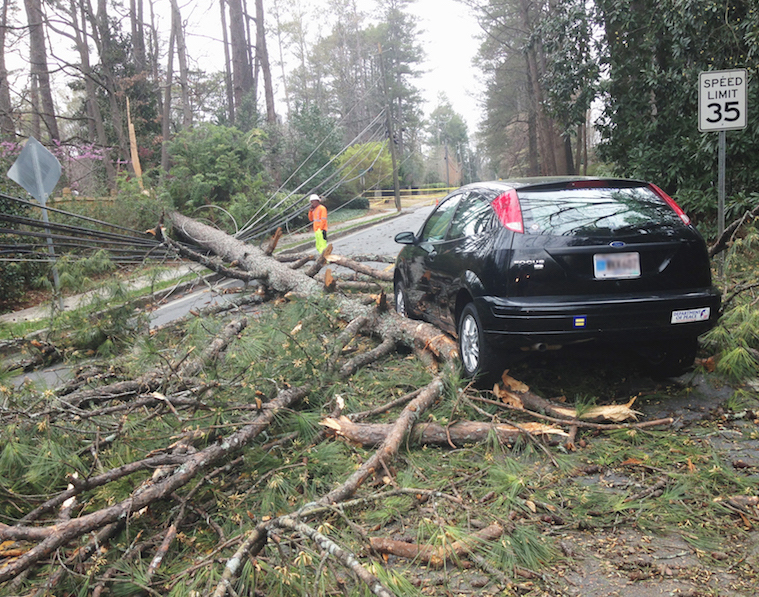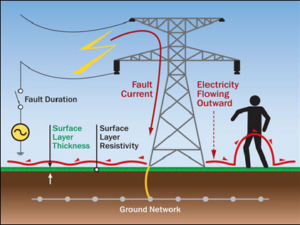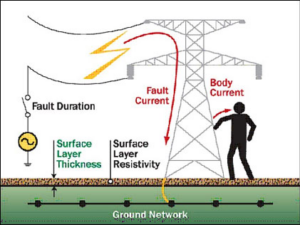Electrical Hazards: Step and Touch Potential

By Keith Pancake and the ACRT Area Safety Representatives
Step and touch potentials are very serious, real hazards that may be encountered by individuals working around utility lines every day. Examples range from responding to an out-of-service ticket with a conductor on the ground, being in close proximity to line crews working on the system, or a tree in contact with the line while inspecting a circuit. The possibilities are endless. Understanding what to do in a situation like this is imperative to keeping safe.

Step potential is a condition caused by the difference in voltage when the ground or walking surface becoming energized. This could be from a downed power line, fault in underground equipment, etc. The point where the line touches the ground has the highest voltage. As we move away from this source the voltage drops, depending on the conductivity of the surface. With step potential, your leading leg is at a higher voltage than the back leg. If your legs cross, the electricity will move through the body to complete the circuit from higher voltage to lower voltage.
If you encounter a downed power line, place your feet together and hop away. Alternatively, you can shuffle your feet, one beside the other (touching) and slide your feet along the ground, never letting the heel of the leading foot pass the toe of the other. Do this until you are approximately 33 feet away. If you are in a vehicle, stay in your vehicle until utility personnel inform you it is safe to exit. If an emergency, such as a vehicle fire, should force you to exit the vehicle immediately, jump from the vehicle without touching any surface and hop or shuffle as previously described.
Do not rely on electrical hazard rating or labeling on boots or tools to prevent injury. While these may reduce risk, dirt or water on the surface will reduce or negate the resistance of these items. Electrical Injuries are often fatal, and if not, can have long-lasting and devastating health consequences. Electrical injuries are the fourth highest cause of work-related deaths according to OSHA.

Touch potential exists when a part of the body can physically become part of the circuit. This could be as simple as touching a power line, or from touching an object that is in contact with a power line. The key thing to remember about touch potential is that you do not have to see the hazard for it to exist. Guardrails on roadways could have a live wire on them at a point that you cannot see. This would cause the entire length of the guardrail to be energized. Chain link fences, barbed wire fences, and field fences can run for blocks and even miles. Avoid touching them — you never know. Green tree parts or wood with living tissue are also good conductors, and touching a tree or tree part that is contacting a power line has the potential to injure or kill.
The best ways to avoid touch potential is to stay aware of your surroundings. Keep an eye out for potential hazards or lines down. Staying alert will reduce the risk of being injured by energized lines or objects.
BEST PRACTICES
- Look for overhead power lines and buried power line indicators
- Stay 10 feet away from overhead lines.
- Assume all overhead lines are energized. Never assume a wire is safe to touch even if it is down or appears insulated.
- Never touch a fallen overhead power line. Call the electric utility to report fallen lines.
Keith Pancake is a safety manager serving ACRT and Bermex. He has been involved in the UVM industry for 10 years. He is an ISA Certified Arborist and Utility Specialist with a bachelor of arts in Geography/GIS from Keene State College and a bachelor of science in Wildlife, Fish and Wildlands Science and Management from Tennessee Technological University.
The ACRT Area Safety Representatives aid in safety communications, safety auditing, identifying at-risk behaviors, and incident investigations throughout ACRT. They actively work with all field supervisors to ensure our safety process is engaged. They conduct any corrective actions, promote safe field operations, and coach those that need the extra help.


